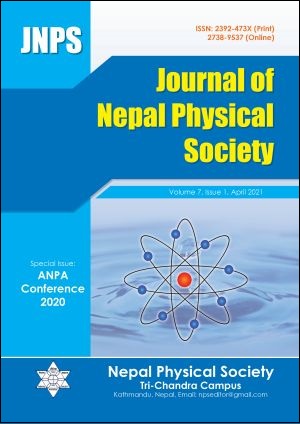GPS-TEC observations over Nepal during the Total Solar Eclipse on 22 July 2009
DOI:
https://doi.org/10.3126/jnphyssoc.v7i1.36976Keywords:
Ionospheric total electron content, Total Solar Eclipse, Global Positioning System, Geomagnetic stormAbstract
This paper explores the ionospheric response in terms of Total Electron Content (TEC) during the 22 July 2009 Total Solar Eclipse. Using the data stored at Biratnagar (BRN2), Ramite (RMTE), Dhangadhi (DNGD), Nepalganj (NPGJ), and Taplejung (TPLJ) Global Positioning System (GPS) stations, the ionospheric activity was investigated through changes in TEC. Our research is based on GPS-TEC measurements from a widely dispersed GPS network across various geographical locations in Nepal, taking place on July 17-21 as a pre-event, July 22 as the main event, and July 23-27 as a post-event. The analysis reveals that the reduction in the TEC level is proportional to the magnitude of the total solar eclipse. The variation of the TEC depends on latitude as well as longitude. We found that TEC depletion was up to 5% from pre-event to main-event and up to 30% from main-event to post-event during the totality of the eclipse. The eclipse was accompanied by the 10-hour geomagnetic storm in Nepal, which was the explanation for the TEC upgrade to 50% on the main event day from pre-event and decreased by 25% from main-event to post-event. The result obtained in this work demonstrates the influence of the eclipse/storm on the variation of TEC.
Downloads
Downloads
Published
How to Cite
Issue
Section
License
All right reserved. No part of this Journal may be reproduced in any form or by any electronic or mechanical means, including information storage and retrieval system, without permission in writing from the publisher, except by a reviewer who may quote brief passage in a review. The views and interpretation in this journal are those of author(s) and they are not attributable to the NPS.




